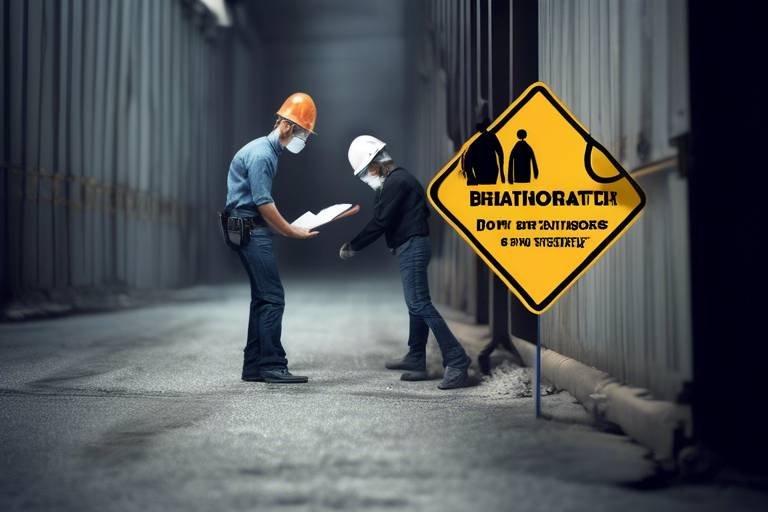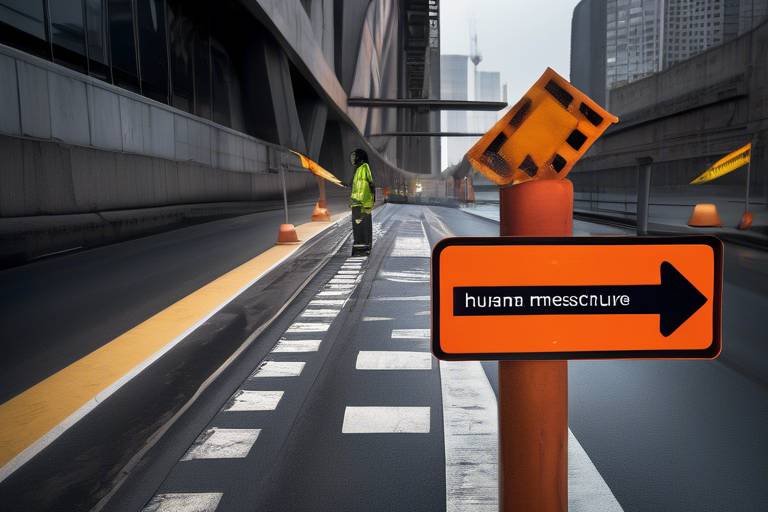Is there a Co-relation between Safety Measures and Human Behavior?
In today's fast-paced world, the relationship between safety measures and human behavior has become a topic of significant interest and importance. As we navigate different environments—be it our workplaces, homes, or public spaces—understanding how safety protocols influence our actions is crucial. Have you ever wondered why some people diligently follow safety rules while others seem to disregard them entirely? This article delves into the intricate dance between safety measures and human behavior, shedding light on how our decisions can be shaped by the systems designed to protect us.
At its core, the co-relation between safety measures and human behavior is not just about rules and regulations; it's a complex interplay of psychology, social dynamics, and individual choices. Imagine safety measures as a sturdy net designed to catch us when we fall, but what happens when we choose to leap outside its boundaries? The effectiveness of these measures often hinges on our perception of risk and how we weigh the consequences of our actions. In essence, our behavior can either reinforce or undermine the very systems put in place to keep us safe.
Moreover, the environment we find ourselves in plays a pivotal role. For instance, in a workplace where safety is prioritized and actively promoted, employees are more likely to comply with safety protocols. Conversely, in an environment where safety is overlooked, individuals may adopt a relaxed attitude, leading to potentially dangerous situations. This raises an important question: how can we create environments that not only enforce safety measures but also encourage individuals to embrace them wholeheartedly?
As we explore this topic further, we will uncover the psychological factors that drive compliance with safety measures, examine the impact of social influence on behavior, and consider how behavioral interventions can enhance adherence to safety protocols. By understanding these dynamics, we can better design safety measures that resonate with individuals and foster a culture of safety that is not only effective but also sustainable.
- What are safety measures? Safety measures are protocols and guidelines implemented to prevent accidents, injuries, and hazards in various environments.
- How does human behavior affect safety measures? Human behavior can significantly influence the effectiveness of safety measures; individuals may comply with or disregard protocols based on various psychological and social factors.
- What role does risk perception play? Risk perception affects how individuals assess the likelihood of danger, which in turn influences their decision-making regarding safety measures.
- Can social influence impact safety compliance? Yes, social environments and peer behaviors can greatly affect individual choices, often leading to either increased compliance or disregard for safety protocols.
- What are behavioral interventions? Behavioral interventions are strategies designed to modify behavior through education, incentives, and reminders to enhance compliance with safety measures.

The Importance of Safety Measures
Understanding the significance of safety measures is crucial for promoting a culture of safety in workplaces and communities. These measures serve as the backbone of any organization, ensuring that individuals can perform their tasks without the looming threat of accidents or injuries. Imagine walking into a factory where safety protocols are strictly enforced; the air feels different, doesn't it? There's a sense of security that allows employees to focus on their work, knowing they are protected. This is not just about compliance; it's about fostering an environment where safety is prioritized and valued.
The implementation of safety measures leads to a myriad of benefits that extend beyond mere accident reduction. For instance, a culture of safety can significantly boost employee morale. When employees see that their well-being is a priority, they are more likely to engage fully with their work, leading to increased productivity. Additionally, organizations that prioritize safety often experience lower insurance costs and reduced liability, which can translate into more funds available for other essential areas of the business.
Moreover, the ripple effect of safety measures can be seen in community settings as well. When safety protocols are established in public spaces—like parks, schools, and community centers—residents feel more secure. This sense of security encourages community engagement and participation, which can lead to stronger social bonds. Safety measures are not just rules; they are a commitment to the well-being of every individual involved.
To illustrate the importance of safety measures, consider the following key points:
- Reduction in Accidents: Proper safety protocols can drastically lower the incidence of workplace and community accidents.
- Enhanced Productivity: A safe environment allows individuals to concentrate on their tasks without fear, leading to higher output.
- Cost Savings: Fewer accidents mean lower insurance premiums and reduced legal liabilities.
- Improved Reputation: Organizations known for their commitment to safety attract better talent and foster customer loyalty.
In conclusion, recognizing the importance of safety measures is not just about adhering to regulations; it’s about building a foundation of trust and responsibility. Whether it’s in the workplace or the community, when safety is prioritized, everyone benefits. It’s a collective effort that requires commitment from all levels, but the rewards—both tangible and intangible—are well worth it.

Human Behavior in Safety Contexts
When we think about safety, it’s easy to focus solely on the measures and protocols in place. However, the reality is that human behavior plays a crucial role in how effective these safety measures really are. Imagine a well-constructed bridge with all the safety features imaginable, yet if people ignore the posted weight limits, the structure’s integrity is compromised. This scenario illustrates a fundamental truth: no matter how robust the safety measures, they are only as effective as the adherence of individuals to those measures.
Understanding human behavior in safety contexts involves delving into the psychological dynamics that influence how people react to safety protocols. For instance, some individuals may comply with safety regulations due to a strong sense of responsibility, while others might dismiss them altogether. This divergence in behavior can be attributed to several factors, including motivation, perception of risk, and the influence of social norms.
Compliance with safety measures can often be linked to psychological factors. For example, when individuals perceive a high level of risk associated with a particular behavior, they are more likely to follow safety protocols. This is where the concept of risk perception comes into play. If someone believes that the potential consequences of their actions are severe, they are more inclined to adhere to safety guidelines. On the other hand, if they underestimate the risks, they may disregard these precautions entirely.
Moreover, social influence cannot be overlooked. People are inherently social creatures; we tend to look to others for cues on how to behave. If a person sees their peers consistently following safety measures, they are more likely to do the same. Conversely, if they observe others ignoring these measures, it can create a sense of normalization around risky behaviors. This highlights the importance of fostering a positive safety culture within any environment, whether it be a workplace or a community.
Risk perception significantly shapes decision-making processes. For instance, consider a construction site where workers are required to wear helmets. If they believe that head injuries are unlikely to occur, they may choose to forgo wearing helmets. Understanding how individuals assess risks can inform the design of safety measures. By enhancing awareness of potential dangers, we can encourage compliance. This can be achieved through educational programs that highlight the real consequences of unsafe behaviors.
Social environments exert a powerful influence on individual choices regarding safety. Think of a scenario where a group of friends decides to engage in risky behavior, like not wearing seatbelts. One person’s decision can affect the entire group, leading to a collective disregard for safety. Therefore, examining these social influences is crucial in tailoring safety initiatives. By creating a culture where safety is prioritized and celebrated, we can encourage individuals to make better choices.
In summary, understanding human behavior in safety contexts is not just about enforcing rules; it’s about recognizing the underlying psychological and social factors that drive compliance. By addressing these elements, we can develop more effective safety protocols that resonate with individuals on a personal level, ultimately leading to a safer environment for all.
- What are the key factors that influence human behavior regarding safety?
Key factors include motivation, risk perception, and social influences. People are more likely to comply with safety measures when they understand the risks involved and when they see others adhering to these protocols.
- How can organizations encourage compliance with safety measures?
Organizations can implement educational programs, promote a positive safety culture, and utilize incentives to encourage adherence to safety protocols.
- Why is understanding human behavior important in safety contexts?
Understanding human behavior helps in designing effective safety measures that resonate with individuals, leading to improved compliance and a safer environment.

The Psychology of Compliance
When we delve into the psychology of compliance, it’s like peeling back the layers of an onion to uncover the motivations that drive human behavior in relation to safety measures. Why do some individuals strictly adhere to safety protocols while others seem to disregard them entirely? Understanding this phenomenon requires us to explore several psychological factors, including motivation, perception of risk, and the influence of social norms.
At the heart of compliance is motivation. Individuals are often driven by a mix of intrinsic and extrinsic motivations. Intrinsic motivation refers to doing something because it is inherently interesting or enjoyable, while extrinsic motivation involves performing a behavior to earn rewards or avoid punishments. For instance, a worker might wear protective gear not only because it’s required but also because they understand the personal benefits of staying safe. This understanding fosters a sense of responsibility and ownership over their own safety.
Next, let's consider risk perception. How individuals assess risk can significantly influence their behavior. Some people might underestimate the dangers associated with certain activities, leading them to ignore safety measures. Others, however, might have a heightened sense of risk, prompting them to go above and beyond in following safety protocols. For example, a construction worker who has witnessed a colleague’s accident may develop a heightened awareness of safety, leading to stricter adherence to safety measures. This highlights the importance of education in shaping risk perception.
Additionally, social norms play a crucial role in compliance. Humans are inherently social creatures, and our behaviors are often influenced by those around us. When safety measures are embraced by a group, individuals are more likely to conform. This is evident in workplace settings where a culture of safety is established. If the majority of employees prioritize safety, newcomers are likely to follow suit. Conversely, if safety measures are disregarded by peers, even the most safety-conscious individuals might feel pressured to conform to the group’s behavior.
To further illustrate these concepts, consider the following table that summarizes the key psychological factors influencing compliance:
| Psychological Factor | Description |
|---|---|
| Motivation | Intrinsic and extrinsic factors driving individuals to comply with safety measures. |
| Risk Perception | How individuals assess and react to potential dangers in their environment. |
| Social Norms | The influence of group behavior on individual compliance with safety protocols. |
Understanding the psychology behind compliance is not just an academic exercise; it has real-world implications for designing effective safety measures. By acknowledging these psychological factors, organizations can tailor their safety initiatives to better resonate with individuals. For instance, implementing training programs that highlight the personal benefits of compliance can enhance intrinsic motivation. Similarly, fostering a culture where safety is prioritized can positively influence social norms, encouraging everyone to take safety seriously.
In conclusion, the psychology of compliance is a complex interplay of various factors. By understanding what drives individuals to adhere to safety measures, we can create a safer environment for everyone. So the next time you see someone following a safety protocol, remember that their behavior is likely influenced by a combination of motivation, risk perception, and social norms. It’s a fascinating area of study that not only helps us understand behavior but also empowers us to create a culture of safety.
- What are the main factors influencing compliance with safety measures?
The main factors include motivation, risk perception, and social norms. - How can organizations improve compliance with safety protocols?
Organizations can enhance compliance by providing education, fostering a safety culture, and offering incentives. - Why is understanding human behavior important for safety measures?
Understanding human behavior helps tailor safety initiatives to be more effective and resonate with individuals.

Risk Perception and Decision-Making
Risk perception is a fascinating concept that significantly influences how we make decisions, particularly in contexts where safety is a concern. Imagine you're standing at the edge of a busy street, waiting to cross. Your perception of the risk involved—how likely you think it is that a car might zoom past without stopping—will dictate whether you wait patiently for the light to change or decide to dash across, hoping for the best. This simple scenario illustrates the profound impact risk perception has on our choices.
When it comes to safety measures, understanding risk perception can be the key to developing effective protocols. For instance, if individuals perceive a low risk of injury in a given situation, they may disregard safety measures altogether. Conversely, if they view the risk as high, they are more likely to adhere to protocols designed to protect them. This dynamic can be influenced by a myriad of factors, including personal experiences, cultural background, and even the media's portrayal of risks.
Interestingly, research has shown that our decision-making processes are often swayed by emotional responses rather than purely rational assessments. For example, if someone has witnessed a serious accident, their emotional reaction may heighten their perception of risk in similar situations, leading them to take extra precautions. On the flip side, a lack of direct experience with a specific risk can lead to complacency, where individuals underestimate potential dangers.
Moreover, social influences play a critical role in shaping our perceptions of risk. We often look to others to gauge how we should react in uncertain situations. If friends or colleagues disregard safety protocols, we might feel emboldened to do the same, even if our internal risk assessment suggests otherwise. This phenomenon highlights the importance of fostering a culture of safety, where positive behaviors are modeled and reinforced.
To illustrate these concepts further, consider the following table that outlines various factors influencing risk perception:
| Factor | Description |
|---|---|
| Personal Experience | Direct involvement in a risky situation can heighten awareness and caution. |
| Cultural Background | Different cultures may have varying attitudes toward risk, affecting behavior. |
| Media Influence | How risks are portrayed in the media can shape public perception and response. |
| Peer Behavior | Observing peers can lead to either heightened caution or increased risk-taking. |
In conclusion, risk perception is not just an abstract concept; it's a driving force behind our decision-making processes. By understanding how individuals assess risks, safety measures can be better tailored to meet people's needs and encourage compliance. After all, the goal is not just to implement safety protocols but to ensure that individuals recognize their importance and feel empowered to act accordingly.
- What is risk perception? Risk perception refers to the subjective judgment people make about the severity and likelihood of a risk.
- How does risk perception influence behavior? Individuals are more likely to adhere to safety measures if they perceive a higher risk associated with not following them.
- Can social factors affect risk perception? Yes, social influences, such as peer behavior and cultural norms, can significantly shape how risks are perceived and acted upon.
- What role does personal experience play in risk perception? Personal experiences, especially negative ones, can heighten awareness of risks and lead to more cautious behavior.

Social Influence on Behavior
When we think about safety, it’s easy to assume that individual choices are solely based on personal beliefs and knowledge. However, the truth is much more complex. Social influence plays a significant role in shaping our behavior, especially when it comes to adhering to safety measures. Imagine being at a party where everyone is wearing a helmet while riding a bike. You might feel a bit silly not joining in, right? This is a classic example of how peer behavior can dictate our actions. The pressure to conform to group norms can either encourage or discourage safe practices.
Research shows that individuals are more likely to comply with safety measures if they see their peers doing the same. This phenomenon is rooted in the psychology of social proof, where people look to others for cues on how to behave. For instance, if a majority of your coworkers wear their safety goggles, you’re more likely to follow suit, even if you initially thought they were unnecessary. This is why creating a culture of safety within groups is so vital—it can lead to a ripple effect of positive behavior.
Moreover, social influence is not just about immediate peers; it extends to broader societal norms. For example, in communities where safety measures are publicly endorsed and celebrated, such as through campaigns or community events, individuals tend to adopt similar attitudes. Consider the impact of social media, where safety campaigns that go viral can significantly alter public perception and behavior. When people see others sharing their commitment to safety, they are more likely to do the same, creating a collective consciousness around safe practices.
However, it's important to recognize that social influence can also have a negative impact. In some cases, if individuals are surrounded by peers who disregard safety protocols, they may feel compelled to follow suit, believing that it’s acceptable behavior. This highlights the need for targeted interventions that not only promote positive behavior but also challenge negative norms. For example, organizations can implement peer-led training sessions that emphasize the importance of safety, leveraging the influence of respected colleagues to encourage compliance.
To summarize, social influence is a powerful driver of behavior, especially in the context of safety. By understanding how peer pressure and societal norms shape our choices, we can design more effective safety initiatives that harness these influences for positive outcomes. Ultimately, fostering an environment where safety is valued and practiced by all can lead to significant improvements in compliance and overall safety.
- How can social influence improve safety compliance?
Social influence can enhance safety compliance by creating a culture where safe practices are the norm, encouraging individuals to follow suit. - What are some examples of negative social influences on safety?
Negative influences can include peer pressure to engage in risky behaviors, such as skipping safety gear or ignoring protocols. - How can organizations leverage social influence for safety?
Organizations can implement peer-led initiatives and campaigns that promote safety, using respected individuals to model and encourage safe behaviors.

Behavioral Interventions for Safety
When it comes to ensuring safety in various environments, behavioral interventions play a pivotal role. These strategies are designed to modify behaviors that either enhance or undermine safety protocols. Think of it this way: just as a gardener prunes a plant to encourage healthy growth, organizations can implement specific interventions to cultivate a culture of safety among individuals. The goal is to create an environment where safety becomes second nature, much like buckling your seatbelt before driving.
One of the most effective ways to encourage safety compliance is through education. This involves informing individuals about the risks they face and the importance of adhering to safety measures. For example, in a workplace setting, conducting regular training sessions can equip employees with the knowledge they need to recognize hazards and understand the protocols designed to mitigate them. When people understand the 'why' behind safety measures, they are more likely to embrace them.
Another key component of behavioral interventions is the use of incentives. Just like a child is more likely to complete their homework if a reward is at stake, employees are often motivated to follow safety protocols when there are tangible benefits. Organizations can implement reward systems that recognize individuals or teams who consistently prioritize safety. This not only boosts morale but also fosters a sense of accountability among peers.
Additionally, reminders play a crucial role in reinforcing safe behaviors. Simple visual cues, such as posters or digital reminders, can serve as constant nudges for individuals to adhere to safety protocols. For instance, placing signs near machinery that highlight the necessary safety gear can remind workers to protect themselves. It’s like having a friend who nudges you to remember your umbrella on a rainy day.
To illustrate the effectiveness of these interventions, let’s take a look at a few successful case studies:
| Case Study | Intervention | Outcome |
|---|---|---|
| Manufacturing Plant | Monthly Safety Training | 30% reduction in accidents |
| Construction Site | Incentive Program for Safety Compliance | 40% increase in safety gear usage |
| Office Environment | Visual Safety Reminders | 50% decrease in workplace injuries |
In conclusion, implementing behavioral interventions for safety is not just about enforcing rules; it’s about creating an environment where safety is valued and prioritized. By combining education, incentives, and reminders, organizations can significantly enhance compliance with safety measures, leading to a safer and more productive environment for everyone.
- What are behavioral interventions? Behavioral interventions are strategies designed to change individuals' behaviors to improve safety compliance and reduce risks.
- How do education and training affect safety? Education and training equip individuals with knowledge about risks and safety measures, increasing the likelihood of compliance.
- What role do incentives play in promoting safety? Incentives motivate individuals to follow safety protocols by offering rewards for compliance, fostering a culture of accountability.
- Can visual reminders improve safety compliance? Yes, visual reminders serve as constant prompts for individuals, reinforcing the importance of adhering to safety measures.

Case Studies on Safety Measures
When we talk about safety measures, it's not just about rules and regulations; it's about real-world applications that have made a significant difference in various environments. Case studies serve as powerful narratives that illustrate the impact of safety protocols on human behavior. They provide us with concrete examples of how safety measures can lead to behavioral changes, ultimately resulting in fewer accidents and injuries. For instance, a manufacturing plant that implemented a comprehensive safety training program saw a remarkable reduction in workplace accidents. Employees became more vigilant and aware of their surroundings, which positively influenced their decision-making processes.
In another instance, a community safety program aimed at reducing traffic accidents showcased how engaging local populations can foster a culture of safety. By organizing workshops and interactive sessions, residents were educated about the importance of adhering to traffic rules. The program not only informed them but also created a sense of collective responsibility. As a result, the area witnessed a significant decrease in road accidents, demonstrating that when people feel involved and informed, they are more likely to change their behavior for the better.
To further illustrate the effectiveness of safety measures, let's take a look at a few key case studies:
| Case Study | Description | Outcome |
|---|---|---|
| Manufacturing Safety Training | A factory implemented a rigorous safety training program for all employees. | Reduced workplace accidents by 40% within the first year. |
| Community Traffic Safety | A local community organized workshops to educate residents about traffic safety. | Decreased road accidents by 30% over two years. |
| Construction Site Protocols | A construction company introduced new safety protocols and equipment. | Lowered injury rates by 50% in the following project. |
These examples highlight that the implementation of safety measures can transform not only the physical environment but also the mindset of individuals within that environment. It’s fascinating to see how a structured approach to safety can lead to a domino effect, where one positive change leads to another. Employees in the manufacturing case study became advocates for safety, encouraging their peers to follow suit. Similarly, community members began to take pride in their safe driving habits, which further reinforced the program's objectives.
Moreover, these case studies reveal a crucial takeaway: engagement is key. When individuals feel a part of the safety process, they are more likely to adhere to the measures put in place. This sense of ownership can turn safety protocols from mere obligations into personal commitments. It’s like being part of a team; when everyone is on board, the chances of success skyrocket.
In summary, the interplay between safety measures and human behavior is profound. The successes seen in these case studies are not just isolated incidents; they are indicative of a broader trend where safety becomes a shared responsibility. By analyzing these real-life examples, we can glean valuable insights into how to design and implement effective safety measures that resonate with individuals, ultimately leading to safer workplaces and communities.
- What are safety measures? Safety measures are protocols and practices designed to prevent accidents and injuries in various environments.
- How can human behavior impact safety measures? Human behavior can either enhance or undermine safety measures, depending on individual compliance and awareness.
- Why are case studies important in understanding safety? Case studies provide real-world examples of how safety measures can influence behavior and lead to positive outcomes.
- What role does community engagement play in safety? Engaging the community fosters a sense of ownership and responsibility, which can lead to better adherence to safety protocols.

Workplace Safety Initiatives
When it comes to workplace safety, the stakes are incredibly high. Imagine a bustling factory floor or a busy office environment; the potential for accidents is always lurking in the shadows. This is where come into play, acting as both a shield and a guide to protect employees and foster a culture of safety. These initiatives are not just about adhering to regulations; they are about creating an environment where safety becomes second nature to everyone involved.
One of the most effective ways to implement safety initiatives is through comprehensive training programs. These programs educate employees about potential hazards and the necessary precautions to take. For instance, a construction company may conduct regular workshops that simulate emergency scenarios, allowing workers to practice their responses. This kind of hands-on training not only equips employees with the knowledge they need but also instills a sense of confidence in their ability to handle emergencies.
Moreover, it’s vital to involve employees in the development of safety protocols. When workers have a say in the safety measures that affect their daily lives, they are more likely to adhere to them. This collaborative approach can lead to innovative solutions tailored to specific workplace challenges. For example, a team might identify a particular area of the workplace that poses a unique risk and suggest a new safety procedure that could mitigate that risk. By empowering employees, companies can cultivate a sense of ownership over safety practices, which can significantly enhance compliance.
In addition to training and involvement, regular safety audits play a crucial role in workplace safety initiatives. These audits help identify potential hazards that may have been overlooked and ensure that safety protocols are being followed. Think of these audits as a health check for the workplace: just as you would visit a doctor for a routine check-up, organizations must regularly assess their safety measures to keep their environment healthy and secure. The findings from these audits can lead to actionable insights, prompting necessary changes or enhancements to existing safety procedures.
| Type of Initiative | Description | Benefits |
|---|---|---|
| Training Programs | Hands-on workshops and simulations to educate employees about safety protocols. | Increased confidence and preparedness in emergency situations. |
| Employee Involvement | Engaging employees in the creation and refinement of safety measures. | Enhanced compliance and ownership of safety practices. |
| Regular Audits | Systematic checks to identify hazards and ensure adherence to safety protocols. | Continuous improvement of safety measures and risk mitigation. |
Lastly, it's essential to create an atmosphere where employees feel comfortable reporting unsafe conditions without fear of reprisal. This can be achieved through anonymous reporting systems or regular feedback sessions. When workers know they can voice their concerns, it leads to a more vigilant workforce. They become the eyes and ears of safety, watching out for each other and actively participating in maintaining a safe work environment.
In conclusion, workplace safety initiatives are not just a checkbox to tick off; they are a vital investment in the well-being of employees and the overall success of an organization. By focusing on training, employee involvement, regular audits, and open communication, companies can create a culture where safety is prioritized, leading to fewer accidents and a healthier workplace. After all, a safe workplace is not only a productive one but also a place where employees can thrive.
- What are the key components of effective workplace safety initiatives?
Effective workplace safety initiatives typically include comprehensive training programs, employee involvement in safety protocol development, regular safety audits, and open communication channels for reporting unsafe conditions. - How can employees contribute to workplace safety?
Employees can contribute by participating in safety training, providing feedback on safety measures, and reporting any unsafe conditions they observe without fear of reprisal. - Why are regular safety audits important?
Regular safety audits are crucial as they help identify potential hazards, ensure compliance with safety protocols, and facilitate continuous improvement of safety measures.

Community Safety Programs
Community safety programs are essential initiatives aimed at fostering a culture of safety within local populations. These programs go beyond just implementing rules; they engage the community in a collaborative effort to identify risks and develop solutions tailored to their unique needs. Imagine a neighborhood where everyone looks out for each other, like a tightly-knit family. This sense of collective responsibility not only enhances safety but also strengthens community bonds.
One of the most effective aspects of community safety programs is their ability to involve residents directly in the decision-making process. When individuals feel a sense of ownership over safety initiatives, they are more likely to participate actively and adhere to the established protocols. For instance, a community might organize workshops that educate residents about local hazards, such as traffic safety or crime prevention. These workshops can serve as a platform for discussion, allowing participants to share their experiences and suggestions on how to improve safety in their neighborhood.
Moreover, community safety programs often utilize social influence to encourage safer behaviors. By highlighting positive role models within the community—such as local leaders or respected peers—these programs can effectively shift attitudes towards safety. For example, if a well-known figure advocates for wearing seat belts or participating in neighborhood watch programs, others are likely to follow suit. This ripple effect can create a safer environment, as more individuals adopt proactive safety measures.
To illustrate the impact of community safety programs, let’s consider a case study involving a city that implemented a comprehensive safety initiative. The program focused on three main areas: crime prevention, traffic safety, and emergency preparedness. Here’s a brief overview of the outcomes:
| Area of Focus | Initiative | Outcome |
|---|---|---|
| Crime Prevention | Neighborhood Watch Programs | 30% reduction in local crime rates |
| Traffic Safety | Community Traffic Safety Workshops | 25% decrease in traffic accidents |
| Emergency Preparedness | Disaster Response Training | Increased community readiness and response time |
As evidenced by this case study, community safety programs not only lead to tangible improvements in safety metrics but also foster a stronger sense of community. When residents work together towards common safety goals, they cultivate an environment where individuals are more likely to look out for one another, reducing risky behaviors and enhancing overall well-being.
In conclusion, community safety programs exemplify the powerful connection between human behavior and safety measures. By engaging residents, leveraging social influence, and fostering a sense of collective responsibility, these initiatives can transform communities into safer places to live. So, next time you think about safety, remember that it’s not just about rules and regulations; it’s about people coming together to create a safer world for everyone.
- What are community safety programs? Community safety programs are initiatives designed to engage local populations in identifying risks and developing solutions to enhance safety in their neighborhoods.
- How do these programs impact human behavior? They foster a sense of collective responsibility, encourage participation, and leverage social influence to promote safer behaviors among residents.
- Can you provide an example of a successful community safety program? Yes! A city that implemented neighborhood watch programs saw a 30% reduction in local crime rates, demonstrating the effectiveness of community engagement in safety initiatives.
Frequently Asked Questions
- What are safety measures?
Safety measures are protocols and practices designed to prevent accidents and injuries in various environments, including workplaces and public spaces. They can range from simple guidelines, like wearing helmets, to comprehensive systems, such as emergency response plans.
- How do safety measures influence human behavior?
Safety measures can significantly shape human behavior by establishing norms and expectations. When individuals understand the importance of these measures and see their peers adhering to them, they are more likely to comply, creating a safer environment for everyone.
- Why do some people ignore safety protocols?
People may disregard safety protocols due to a variety of reasons, including a lack of awareness, perceived invulnerability, or the influence of social norms that downplay risks. Understanding these psychological factors is key to improving compliance.
- What role does risk perception play in decision-making?
Risk perception is crucial in decision-making as it affects how individuals evaluate potential hazards. If someone perceives a situation as risky, they are more likely to follow safety measures. Conversely, if they underestimate the risks, they may neglect these important protocols.
- How can social influence affect safety behavior?
Social influence can greatly impact safety behavior. If individuals see their peers actively engaging in safety practices, they are more likely to follow suit. Conversely, if they witness risky behaviors being normalized, they may feel compelled to join in, potentially leading to unsafe situations.
- What are behavioral interventions for enhancing safety compliance?
Behavioral interventions aim to modify individual actions through strategies like education, incentives, and reminders. For example, implementing training programs or offering rewards for safe behavior can encourage compliance with safety measures.
- Can you provide examples of successful safety initiatives?
Yes! Numerous case studies illustrate the success of safety initiatives. For instance, workplace safety programs that involve employee training and engagement have led to significant reductions in accidents. Similarly, community safety programs that involve local residents can foster a sense of collective responsibility, enhancing overall safety.



















